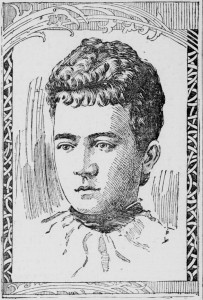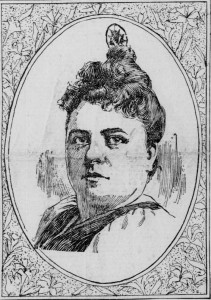The Dover poisoned candy murders
One evening in August 1898 in Dover, Delaware, the family of ex-congressman John B. Penington sat together on the porch of their house on the Dover Green. Mr. and Mrs. Penington, their son, two adult daughters and their grandchildren were relaxing after dinner. Two neighbors stopped by to say hello. One of the daughters, Elizabeth Dunning, had received a box of chocolates in the mail earlier that day, and she passed the candy around for her family and friends to enjoy. Later that night, everyone who had eaten the candy got sick. Elizabeth Dunning and her sister, Ida Deane, had eaten more candy than the others. Within a few days, both women were dead. Food poisoning was originally suspected, but tests on the candy proved it had been laced with arsenic.
The candy had been sent with no return address but a San Francisco postmark. Included in the box was a handkerchief and a note that read “With love to yourself and baby, love, Mrs. C.” When informed of his wife Elizabeth’s death, her husband John P. Dunning, immediately suspected his mistress, Cordelia Botkin.

Photo from “The Staff Correspondent”
Born in Delaware, John P. Dunning studied to be an attorney, but the staid life of a provincial Dover lawyer wasn’t for him. He became a foreign correspondent for the Associated Press, traveling the world to cover stories of war and natural disaster. In 1889 he was sent to Samoa to cover the growing tension there between Germany and the United States. Dunning arrived in time to witness the destruction of the fleets sent by the two countries in a terrible cyclone. His story was sent by the AP to newspapers around the world, including the New York Times. His coverage of the cyclone and courage in rescuing victims of the disaster made him a well-known reporter.
Dunning and his wife Elizabeth had a daughter and moved to San Francisco, where Dunning worked for the Associated Press. At some point, Elizabeth and John separated, Elizabeth and her daughter moving back to Dover to live with her parents. Dunning stayed in San Francisco, where he began an affair with Cordelia Botkin. Botkin was also married and separated from her husband.
At the outbreak of the Spanish American War in 1898, Dunning was sent by the Associated Press to Cuba to cover the war, where he covered the exploits of Teddy Roosevelt’s Rough Riders. Before he left, he told Cordelia that after the war he’d be going home to his wife in Delaware. Not long afterward, his wife and her sister were dead.
Cordelia Botkin was soon arrested and charged with the murder of Elizabeth Dunning. Her trial was a huge sensation, with front page coverage in newspapers all over the country. The case had everything needed for a sensational story: adultery, prominent people, the clash between small town values and big city sophistication, and a murder committed by the latest technology, poison by mail.
Cordelia Botkin steadfastly maintained her innocence and hired some of the finest lawyers in San Francisco, but she was found guilty of murder in December 1898. In 1901 her conviction was overturned (People v. Botkin, 132 Cal. 231, 64 P. 286 (1901)) because of improper jury instructions. She was tried and convicted again in 1904 and sentenced to life in prison. She appealed again but this time her conviction was upheld People v. Botkin, 9 Cal. App. 244, 98 P. 861 (1908). She died in San Quentin prison in 1910. John Dunning preceded her in death, dying in Philadelphia in 1907 at the age of 44.
Sources:
John R. Alstadt, Jr. With Love to Yourself and Baby. Dorrance, 2001.
Charles Sanford Diehl. The Staff Correspondent. Clegg Co., 1931.
Thomas S. Duke. Celebrated Criminal Cases of America. J.H. Barry, 1910.
The San Francisco Call‘s extensive coverage of the trial is available at the California Digital Newspaper Collection.

